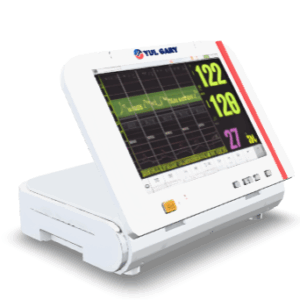Description
The Bedside Monitor YG1674 is a sophisticated solution engineered for continuous and precise monitoring of patient vital signs in healthcare environments. Its intuitive 12.1-inch touchscreen allows healthcare professionals to access critical patient data swiftly. This multi-parameter monitor offers a diverse range of monitoring capabilities, including 5-lead ECG, respiration monitoring, NIBP, SpO2 (COMEN/Nellcor/Masimo), and single-channel temperature. The YG1674 supports dual-IBP, EtCO2, AG, ICG, and C.O., ensuring adaptability to a wide range of clinical needs and providing real-time patient insights.
Market Price
In the competitive world of bedside monitors, the Bedside Monitor YG1674 stands out due to its high-end features and advanced capabilities. These devices are typically available within a market range of approximately $1900 to $2700 USD, reflecting the technological sophistication and value they bring to various healthcare settings. This pricing allows both large medical centers and smaller healthcare facilities to access its advanced technology without compromising on patient care quality.
Frequently Asked Questions
What vital signs can the YG1674 monitor? The YG1674 is designed to measure ECG, SpO2, heart rate, respiration rate, temperature, NIBP, EtCO2, and dual-IBP. Additionally, it provides arrhythmia and ST segment analysis, making it particularly beneficial in critical and emergency care scenarios.
How does the YG1674 monitor respiratory status? It employs impedance respiration monitoring, measuring respiratory rate through the impedance between RA-LL leads, ensuring accurate, real-time breathing pattern assessments and providing alarms for apnea and abnormal respiration.
Can the YG1674 be used in mobile healthcare units? Yes, it is equipped for both wired and wireless network use, making it suitable for stationary and mobile healthcare units. Moreover, it supports trolley and wall mounting for flexibility in clinical settings.
Advantages and Disadvantages
Advantages:
- Comprehensive Monitoring: The YG1674 offers extensive vital sign monitoring, including ECG, NIBP, SpO2, and respiration, serving as a complete monitoring solution.
- Advanced Diagnostic Features: Capabilities such as arrhythmia detection and ST segment analysis facilitate quick identification of potential health issues.
- Wireless and Wired Connectivity: The device’s connectivity options ensure seamless integration into various healthcare environments.
Disadvantages:
- Initial Investment: Its advanced features may result in a higher initial cost, a potential concern for budget-conscious practices.
- Complex Interface: Extensive features may necessitate adequate training for optimal utilization, which could be a challenge for some users.
- Size and Mobility: The relatively large 12.1-inch display may be cumbersome in extremely confined or portable spaces.
Use of the Product in the Field
The YG1674 is a critical tool for emergency rooms, ICUs, and operating theaters, ensuring continuous monitoring of vital signs during surgeries and recovery periods. Its ST segment and arrhythmia analyses are especially advantageous for cardiac surgery or heart condition patients, facilitating early detection of rhythm irregularities. Additionally, its ability to monitor EtCO2 and ICG is vital for assessing cardiovascular and respiratory health during surgical and post-operative recovery phases.
Recommendations
To maximize the performance of your YG1674, regular calibration and maintenance of ECG and NIBP sensors are advisable for long-term accuracy. Ensure seamless integration into your hospital’s network by routinely testing network connections, whether wireless or wired. Make sure that your team is well-versed in all alarm systems, especially apnea alarms, and familiarize them with the arrhythmia and ST segment analysis functions to fully leverage the monitor’s capabilities.
Features
- 12.1-inch touch screen for intuitive interface
- Multi-parameter capabilities including ECG, NIBP, SpO2, and temperature
- Advanced features like dual-IBP, EtCO2, and arrhythmia detection
- Compatible with wired and wireless networks
- Suitable for stationary and mobile healthcare units
Technical Specifications
| Model | YG1674 | |
| ECG | Lead mode | 5 Leads(RA,LA,LL,RL,V) |
| Connection method | I, II, III,AVR,AVL,AVF,V | |
| Lead Mode | 3 Leads (RA,LA,LL) | |
| Connection method | I, II,III | |
| Waveform | 1ch | |
| Gain | 1.25, 2.5, 5.0, 10, 20, 40mm/mV, Auto. | |
| HR Range | Adult: 15~300bpm | |
| Neo/Ped | 15~350bpm | |
| Accuracy | ±1% or ±1bpm | |
| Resolution | 1bpm | |
| Sensitivity | >200(uVp-p) | |
| Differential input impedance | ≥5MΩ | |
| ST segment Monitoring Range | ||
| Measure Range | -2.0~+2.0mV | |
| Measure Accuracy | -0.8mV~+0.8mV | |
| Heart Rate | Measuring range | 15~300bpm |
| Accuracy | ±1bpm | |
| Resolution | 1bpm | |
| Sensitivity | >200UVp-p | |
| Respiration | Method | Impedance between R-F(RA-LL) |
| Differential Input Impedance | >2.5MΩ | |
| Measuring Impedance Range | 0.3~3.0 MΩ | |
| Base line Impedance Range | 200~4000Ω | |
| Bandwidth | 0.1~2.5Hz | |
| Resp. Rate | Adult: 2~120BrPM | |
| Neo/Ped | 0~150BrPM | |
| Resolution | 1 BrPM | |
| Accuracy | ±2 BrPM | |
| Alarm | 10~40S | |
| NIBP | Method | Oscillometric |
| Mode | Manual/Auto/STAT | |
| Measuring Interval in AUTO Mode | 1,2,3,4,5,10,15,30,60,90,120,180,240,480(Min) | |
| Measuring Period in STAT Mode | 5 Min | |
| Pulse Rate Range | 40~240bpm | |
| Alarm Type | SYS, DIA, MEAN | |
| Resolution | ||
| Pressure | 1mmHg | |
| Accuracy | Maximum Mean error: 5mmHg | |
| Maximum Standard deviation | 8mmHg | |
| SPO2 | Display | Number of SPO2,waveform of capacity,Pulse |
| Measuring range | 0~100% | |
| Resolution | 1% | |
| Accuracy | 60~100% (±2%) | |
| Alarm system | Audio-video alarm | |
| Pulse rate range | 0~300bpm | |
| TEMP | Channel | 2 |
| Measuring and Alarm Range | 0~50ºC | |
| Resolution | 0.1ºC | |
| Accuracy | 0.1ºC | |
| Actualization interval | About 1 Second. | |
| Average Time Constant | <10 Second. | |



